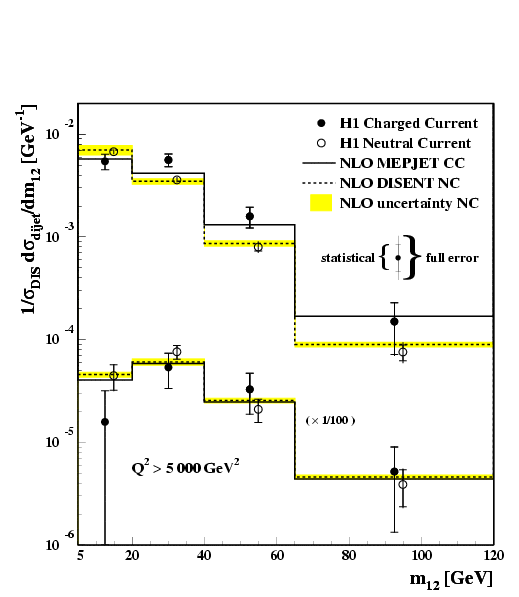Dijet Production in Charged and Neutral Current e+p Interactions at High Q2 |
 In
the violent collisions of electrons and protons that take place at the
HERA accelerator, an electron may directly hit a quark, a constituent of
the proton. The electron is deflected and measured at a large scattering
angle in the particle detector. The recoiling quark gives rise to a collimated
bundle of energetic hadrons, called a jet. In some 10% of these events
a second jet is observed. The second jet is caused by the strong interaction,
one of the four fundamental physical interactions, which enables quarks
to radiate a gluon, very similar to the bremsstrahlung photon radiated
off an electric charge by the electromagnetic interaction.
In
the violent collisions of electrons and protons that take place at the
HERA accelerator, an electron may directly hit a quark, a constituent of
the proton. The electron is deflected and measured at a large scattering
angle in the particle detector. The recoiling quark gives rise to a collimated
bundle of energetic hadrons, called a jet. In some 10% of these events
a second jet is observed. The second jet is caused by the strong interaction,
one of the four fundamental physical interactions, which enables quarks
to radiate a gluon, very similar to the bremsstrahlung photon radiated
off an electric charge by the electromagnetic interaction.
Events with pronounced jet structure could not be produced in earlier electron-proton experiments where the available energy was not sufficient. Only with the advent of HERA was this made possible. Particle physicists are interested in the analysis of the dijet events because it allows the strength and other properties of the strong force to be measured.
Much less frequent are events, where no scattered electron but a neutrino, the electrically neutral partner of the electron, is (indirectly) observed in the detector. As above, in these events one or more jets should be observed, since gluon emission off a quark is expected to be independent of the interaction between the electron and quark. Since the number of detected neutrino events is small, this expectation could not be verified experimentally until now.
In this analysis, we investigate the jet structure of events with a neutrino in the final state in detail. The existence of neutrino events with two jets is experimentally established and the properties of these jets are studied for the first time. The measurements are in good agreement with the theoretical expectations. We also compare the jet properties of the neutrino and electron events directly. We thus verify experimentally the hypothesis that gluon radiation off a quark proceeds essentially in the same way for the electron and the neutrino events.
An example of the measurements is given in the figure. It shows the
distribution of the invariant mass m12 of the two jets and a
comparison to theoretical predictions.
Last Update Oct 7, 2000.